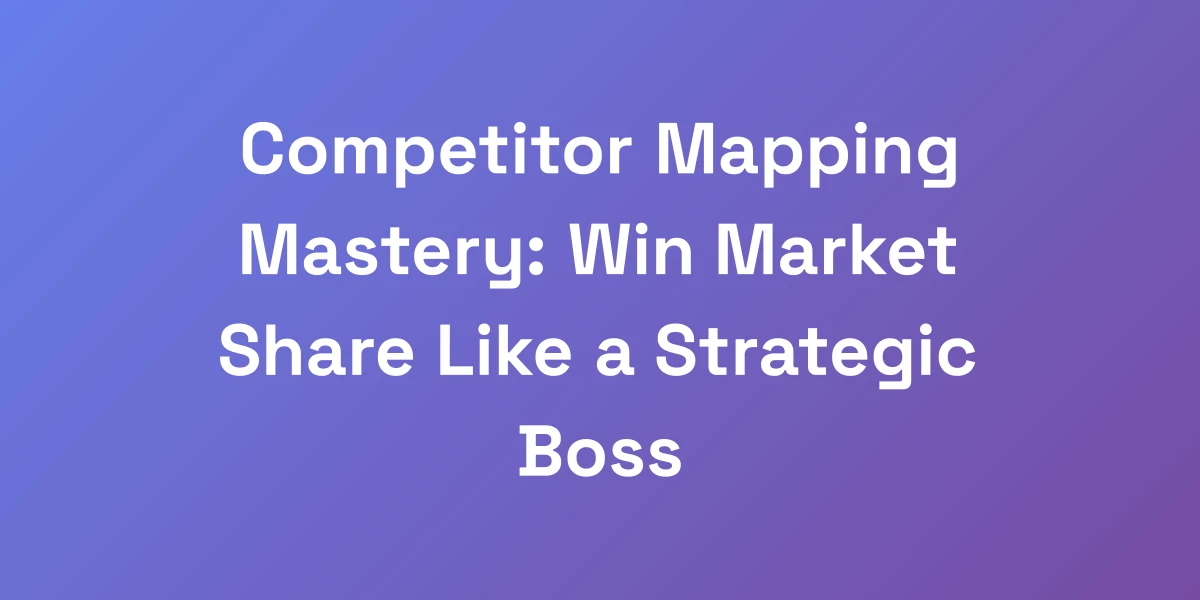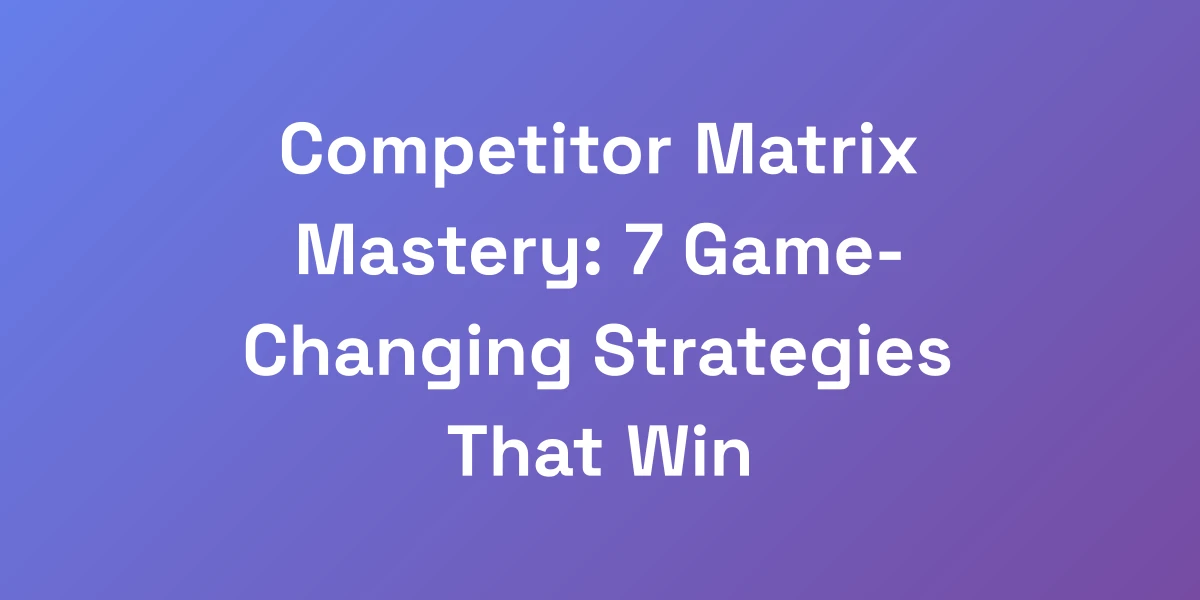
Competitor Mapping Mastery: Win Market Share Like a Strategic Boss
Mar 11, 2025 | By [email protected]
Ever feel like your business is spinning its wheels while your competitors are sprinting ahead? We’ve all been there – grinding day in and day out, only to watch others snatch up the market share you’ve worked so hard to earn. But what if we told you that the real difference between the struggling 90% and the thriving 10% isn’t just about having a stellar product or an innovative service? It’s about mastering the art of competitor mapping.
Most businesses are stuck playing checkers, making moves one step at a time, while their competitors are strategizing like grandmasters, thinking several moves ahead. The lack of a robust competitor analysis example is the silent killer of many promising ventures. But here’s the kicker: competitor mapping isn’t just about creating pretty charts – it’s about developing a killer instinct for market opportunities.
In this comprehensive guide, we’re diving deep into Competitor Mapping Mastery: Win Market Share Like a Strategic Boss. We’ll break down why 90% of businesses fail at competitor analysis and how you can join the elite 10% that dominate their markets. Ready to transform your strategy and start reaping the rewards? Let’s get started.
Why 90% of Businesses Fail at Competitor Analysis (And How to Join the Elite 10%)
Let’s kick things off with some hard truths. According to the U.S. Bureau of Labor Statistics, about 23.2% of private sector businesses fail within their first year. That’s nearly a quarter of new ventures walking away due to poor market analysis, including misunderstanding consumer needs and market conditions. It’s not just bad luck – it’s a lack of strategic competitor mapping.
The Real Cost of Flying Blind in Your Market
Imagine trying to navigate a ship without a compass. That’s what it’s like running a business without understanding your competitive landscape. Flying blind means missing out on crucial market opportunities, wasting resources on ineffective strategies, and ultimately, watching your competitors take the lead. The financial toll is staggering – millions of dollars in lost revenue and wasted marketing budgets that could have been allocated more effectively with proper competitor insights.
What Sets Elite Competitor Analysis Apart
So, what do the top 10% of businesses do differently? It’s not just about tracking your competitors’ actions; it’s about deeply understanding their strategies, strengths, and weaknesses. Elite competitor analysis involves a systematic approach to gather, analyze, and act on competitive intelligence. This means not only knowing who your competitors are but also anticipating their next moves and leveraging that knowledge to your advantage.
The Psychological Edge of Understanding Your Competition
Knowledge is power, especially in business. When you truly understand your competitors, you gain a psychological edge. You can predict market trends, identify gaps, and tailor your strategies to exploit weaknesses in your competitors’ offerings. This proactive approach fosters a culture of agility and innovation within your own team, keeping you one step ahead in the game.
Why Traditional Competitor Analysis Falls Short
Most businesses stick to outdated methods of competitor analysis, such as sporadic SWOT analyses or surface-level research. These traditional approaches often fail to provide the depth and actionable insights needed to drive significant growth. They leave you reactive rather than proactive, always one step behind your competitors.
The New Way to Map Competition (That Actually Works)
It’s time to ditch the old playbook. The new way to map competition involves a comprehensive, data-driven approach that integrates advanced tools and techniques. This means leveraging AI-powered platforms, real-time data analytics, and strategic frameworks that turn competitor insights into actionable strategies. By adopting this modern approach, you can transform your competitor mapping from a passive exercise into a dynamic, revenue-driving activity.
The Ultimate Framework for Creating Competitor Maps That Actually Drive Revenue
Stop wasting time with outdated competitor analysis methods that don’t move the needle. The game has changed, and you need a framework that converts market intelligence into revenue. We’ve developed a foolproof system to help businesses 10x their market share in under 12 months by focusing on the variables that truly matter.
Identifying Your True Competitors (Hint: They’re Not Who You Think)
First things first: not all competitors are created equal. It’s easy to identify direct competitors – those offering similar products or services. However, elite businesses go beyond the obvious and identify indirect competitors and emerging threats that could disrupt the market. This comprehensive view ensures you’re not blindsided by new entrants or alternative solutions that could siphon off your customer base.
- Direct Competitors: Businesses offering the same products or services.
- Indirect Competitors: Companies providing alternative solutions that meet the same customer needs.
- Emerging Competitors: New entrants that could disrupt the market with innovative approaches.
The Critical Variables That Actually Matter
Focusing on the right variables is crucial for meaningful competitor mapping. Instead of getting lost in irrelevant metrics, hone in on factors that influence buying decisions and market dynamics. These include:
- Market Share: Understanding the distribution of market ownership.
- Pricing Strategies: How competitors price their products compared to yours.
- Product Features: The unique selling points and functionalities offered.
- Customer Reviews: Insights into customer satisfaction and pain points.
- Marketing Channels: The platforms and methods competitors use to reach their audience.
Creating Your Data Collection System
Data is the backbone of competitor mapping. Establish a robust system to collect, organize, and analyze data from various sources. This includes:
- Web Scraping Tools: Automatically gather data from competitor websites.
- Social Media Monitoring: Track competitors’ social media activities and engagement.
- Customer Feedback Platforms: Analyze reviews and feedback to gauge customer sentiment.
- Financial Reports: Understand competitors’ financial health and investment areas.
- Digital Advertising Companies in India: Leveraging services from digital advertising companies in India can enhance your competitive intelligence with expert digital strategies.
By centralizing your data collection efforts, you ensure that you have a 360-degree view of your competitive landscape, enabling more informed decision-making.
Building Your First Strategic Map
With your data in hand, it’s time to create your strategic map. This visual representation will help you identify where you stand in the market and highlight opportunities for growth. Here’s how to build one:
- Choose Your Dimensions: Select key metrics like price vs. quality or market share vs. growth rate.
- Plot Your Competitors: Place each competitor on the map based on your chosen dimensions.
- Identify Gaps: Look for areas on the map with few or no competitors – these are your opportunities.
- Analyze Positioning: Assess your position relative to competitors and determine strategies to move ahead.
This visual tool not only clarifies your competitive position but also serves as a strategic guide for future actions.
Advanced Mapping Techniques for Market Domination
Once you’ve mastered the basics, it’s time to elevate your competitor mapping with advanced techniques:
- Heat Maps: Highlight areas of high competition or under-served markets.
- Bubble Charts: Represent multiple variables, such as market share and customer satisfaction, in a single view.
- SWOT Analysis: Break down strengths, weaknesses, opportunities, and threats for each competitor.
- Trend Analysis: Track changes over time using diff checker tools to anticipate future moves and market shifts.
These advanced techniques provide deeper insights, allowing you to anticipate market trends and stay ahead of the curve.
Converting Insights into Action Plans
Data and maps are only valuable if they drive action. The key is to translate your competitor insights into actionable strategies. Here’s how:
- Set Clear Objectives: Define what you want to achieve based on your competitor analysis – whether it’s increasing market share, entering a new segment, or enhancing product features.
- Develop Tactical Plans: Create specific tactics that align with your strategic goals, such as launching a new marketing campaign or optimizing your pricing strategy with content marketing leadership and adopting specialized hotel SEO strategies for industry-specific growth.
- Allocate Resources: Assign the necessary resources to implement your strategies effectively.
- Monitor Progress: Continuously track the performance of your initiatives and adjust as needed.
By systematically converting insights into action, you ensure that your competitor mapping directly contributes to your business’s growth and success.
5 Game-Changing Competitor Mapping Tools That Will Transform Your Strategy
Listen up, because this is where most businesses leave money on the table. The right tools don’t just save you time – they give you insights your competitors can’t see. We’ve tested dozens of competitor mapping tools, and here’s the exact stack that’s generated millions in revenue for our clients. These aren’t just any tools – these are the weapons that market leaders use to stay three steps ahead of their competition. And the best part? Most of your competitors don’t even know these exist.
Essential Tools for Data Collection and Analysis
Data collection is the foundation of effective competitor mapping. These tools help you gather and analyze data effortlessly:
- SEMrush: A powerhouse for SEO and competitor analysis, SEMrush provides insights into competitors’ keywords, backlinks, and traffic sources.
- Ahrefs: Another top-tier SEO tool, Ahrefs excels in backlink analysis and content research, allowing you to see what’s driving your competitors’ success.
- Brand24: This media monitoring tool tracks online mentions and sentiment, giving you real-time insights into competitors’ brand perception.
- Best Backlinking Services: Specialized services that utilize best backlinking services to build high-quality backlinks that enhance your domain authority.
Visualization Tools That Create Instant Insights
Once you have the data, visualization tools help you make sense of it quickly and effectively:
- Tableau: A leading data visualization tool, Tableau allows you to create interactive and shareable dashboards, making it easier to interpret complex data sets.
- Power BI: Microsoft’s Power BI integrates seamlessly with other Microsoft products, offering robust data visualization and business intelligence capabilities.
- Google Data Studio: A free tool that connects with your existing Google products, Google Data Studio helps you create customized reports and dashboards.
AI-Powered Competitive Intelligence Platforms
The future is here with AI-powered platforms that take competitor analysis to the next level:
- Crimson Hexagon: Utilizing AI and machine learning, Crimson Hexagon analyzes vast amounts of social media data to provide deep insights into competitor activities and consumer sentiments.
- Kompyte: An AI-driven competitor tracking tool, Kompyte continuously monitors competitors’ digital footprints, alerting you to changes and trends in real-time.
- SimilarWeb: Leveraging AI, SimilarWeb offers comprehensive traffic and engagement metrics, helping you understand how visitors interact with your competitors’ sites.
Market Research Tools Worth Their Weight in Gold
In-depth market research tools are crucial for understanding broader market dynamics and competitor positioning:
- Nielsen: A trusted name in market research, Nielsen provides comprehensive data on consumer behavior and market trends, helping you make informed strategic decisions.
- Gartner: Known for its detailed industry reports and insights, Gartner helps businesses understand market developments and competitive landscapes.
- SurveyMonkey: This tool allows you to gather direct feedback from consumers, providing invaluable insights into customer preferences and competitor perceptions.
Integration Tools for Real-Time Competition Tracking
Staying updated in real-time is essential for proactive competitor mapping. These integration tools help you monitor competitors continuously:
- Zapier: Automate workflows by connecting your competitor analysis tools with your CRM, email marketing, and other business applications.
- IFTTT (If This Then That): Create custom triggers and actions to receive real-time updates on competitors’ activities across various platforms.
- Slack Integrations: Use Slack’s integrations to receive real-time notifications and updates on competitor movements directly in your team’s communication channels.
From Analysis to Action: Turning Competitor Maps into Market Dominance
Here’s where the rubber meets the road. Having a beautiful competitor map is worthless if you don’t know how to turn those insights into market-crushing actions. We’re going to show you exactly how to translate your competitor analysis into strategic moves that capture market share. This is the exact process we’ve used to help companies identify and exploit gaps in the market worth millions. It’s time to stop analyzing and start executing.
Creating Your Strategic Response Framework
A strategic response framework is your blueprint for turning insights into action. Here’s how to build one:
- Define Strategic Goals: What do you want to achieve? Increased market share, improved product features, enhanced customer service?
- Develop Tactical Plans: Create specific tactics that align with your strategic goals, such as launching a new marketing campaign or optimizing your pricing strategy with content marketing leadership and adopting specialized hotel SEO strategies for industry-specific growth.
- Allocate Resources: Ensure you have the necessary resources to implement your tactics effectively.
- Set Milestones and KPIs: Define key performance indicators and set milestones to measure progress and success.
By establishing a clear framework, you ensure that your strategic actions are aligned with your business objectives and are measurable for success.
Identifying and Exploiting Market Gaps
Market gaps are opportunities where customer needs are unmet or underserved. Here’s how to identify and exploit them:
- Analyze Customer Feedback: Look for recurring complaints or suggestions that indicate unmet needs.
- Study Competitors’ Weaknesses: Identify areas where competitors are falling short and develop solutions to address those gaps.
- Innovate with New Features: Introduce unique features or services that differentiate your offerings from the competition.
Developing Competitive Advantages That Stick
Competitive advantages are what set your business apart and keep customers coming back. Here’s how to develop them:
- Unique Value Proposition (UVP): Clearly articulate what makes your product or service unique and why customers should choose you over competitors.
- Quality and Consistency: Deliver consistently high-quality products or services to build trust and loyalty.
- Customer Experience: Create a superior customer experience through excellent service, easy onboarding, and responsive support.
Building Your 90-Day Action Plan
To maintain momentum, develop a 90-day action plan that outlines your strategic initiatives and tracks their progress. Here’s a step-by-step approach:
- Set Clear Objectives: Define what you aim to achieve in the next three months based on your competitor analysis.
- Outline Action Steps: Break down each objective into actionable steps with assigned responsibilities.
- Allocate Resources: Ensure each action has the necessary resources and support.
- Monitor Progress: Regularly review progress, adjust plans as needed, and celebrate wins along the way.
A structured 90-day plan keeps your team focused and accountable, driving continuous progress toward your strategic goals.
Measuring and Adjusting Your Strategy
Effective strategies require ongoing measurement and adjustment. Here’s how to stay on track:
- Track Key Metrics: Monitor KPIs that align with your strategic goals, such as market share growth, customer acquisition rates, and revenue increases.
- Analyze Performance Data: Regularly review performance data to identify what’s working and what’s not.
- Make Data-Driven Decisions: Use your analysis to make informed adjustments to your strategies, ensuring continuous improvement and adaptation to market changes.
By maintaining a cycle of measurement and adjustment, you ensure your strategies remain effective and aligned with your business objectives.
Case Studies of Successful Market Takeovers
Let’s look at some real-world examples of businesses that leveraged competitor mapping to dominate their markets:
- Dollar Shave Club: By identifying a gap in the men’s grooming market – overpriced razors – Dollar Shave Club disrupted the industry with a subscription-based model, offering affordable and convenient shaving products directly to customers.
- Airbnb: Recognizing a lack of budget-friendly accommodation options during popular events, Airbnb created a global platform connecting homeowners with travelers seeking unique lodging experiences, revolutionizing the hospitality industry.
- Slack: Through meticulous competitor analysis, Slack identified the need for streamlined team communication tools and developed a platform that addressed inefficiencies in traditional communication methods, quickly becoming a market leader.
These case studies illustrate the transformative power of strategic competitor mapping. By understanding and exploiting market gaps, these companies didn’t just compete – they redefined their industries.
Conclusion
Competitor mapping isn’t just a buzzword – it’s a critical strategy for any business aiming to dominate its market. By understanding why 90% of businesses fail at competitor analysis and leveraging the frameworks and tools we’ve discussed, you position yourself in the elite 10% poised for success.
Remember, it’s not enough to simply know who your competitors are. You need to deeply understand their strategies, anticipate their moves, and turn those insights into actionable plans that drive revenue and market share. The tools and frameworks provided here are your roadmap to achieving that mastery.
Ready to take your competitor mapping to the next level? Start implementing these strategies today and watch your business transform into a market leader. Have questions or want to share your own experiences with competitor mapping? Drop a comment below – we’d love to hear from you!







